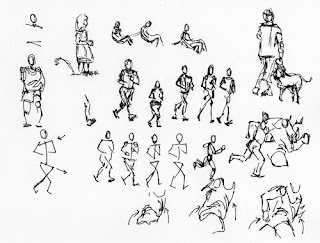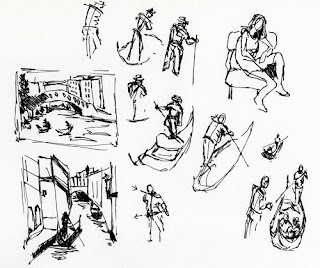When I took life drawing class back in college, gesture drawing was used as a warm up exercise. That's a pretty short-sited approach to take. The definition of gesture drawing is to capture the energy and movement of the subject matter - or to capture the essence of the pose. While gesture drawing is typically used in figure drawing, I see no reason why I can't use the same approach with still lifes or landscapes.
I've been reading Walt Stanchfield' s book "Drawn to Life". He must have been a very enthusiastic and vibrant individual because it really comes across in his writings and his drawings. Here are a few gesture drawing tips I've gleamed from his book:
1. Use a fountain or pen & ink. Use cheap paper so you have no hesitancy to do lots of renderings.
2. Exaggerate the pose. if the body is leaning over, lean it "more". This creates more drama and 'essence' of the pose.
3. Try the pose yourself. Feel the shift of the shoulders, the weight on one leg, the position of the hips, the stretch of an arm. This will help you "feel" the pose and understand what the muscles are doing.
4. Always include the hands and feet in the gesture drawing. They are the most expressive parts!
5. Work to capture the weight of the body. (If the head is leaning against a hand, make sure the "weight" of the head is apparent in the hand. The position of the arm to head is important.)
6. Action, reaction. Squash and stretch. If the body is bent over, the back stretches and the stomach squashes. If the leg bends, the front of the knee stretches and the back of the knee squashes. In
 every movement there is an action/reaction.
every movement there is an action/reaction.5. Clothes will react in a like manner (squash and stretch) and will enhance the gesture. Manipulation of the wrinkles, lumps, bulges, folds, seams will enhance the gesture. "A real solid, expressive, sparkly drawing in one where the clothing is doing what the body is causing it to do."
7. A pose is always doing an action, even sitting.
8. Avoid tangents. (Lines meeting at the same point. It's the death to depth. (I'll address this later with examples)
9. Draw with verbs not nouns. Add adverbs for drama. (Example: Don't just draw the body part...arm, elbow, hair. Instead portray a woman "bending" over, "stretching" her arms to dry her "wet" hair.)
10. Gesture drawing will solidify your understanding of the pose. You can work out th
 e pose, modify, elaborate, change it to 'tell' your story more effectively. Better planning before you start your portrait.
e pose, modify, elaborate, change it to 'tell' your story more effectively. Better planning before you start your portrait.Gesture drawings can range from capturing the mass of the figure, to contours, to simple stick figures. The purpose is to capture the essence of the pose.
You can see in my drawings that I've repeated a pose several times. They go from fairly detailed gestures to simple stick figures. Each one trying to understand the pose.
So how can gesture drawing help you draw realistically?
Just think of the powerful impact of understanding anatomy and applying creative energy/essence of gesture drawing on your drawings. Your portraits will come 'alive' on the paper!
No comments:
Post a Comment